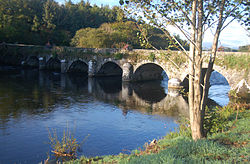Beaufort
Lios an Phúca | |
|---|---|
Village | |
 Beaufort Bridge | |
| Coordinates: 52°04′08″N 09°38′20″W / 52.06889°N 9.63889°W | |
| Country | Ireland |
| Province | Munster |
| County | County Kerry |
| Elevation | 34.155 m (112.056 ft) |
| Population (2016)
[1] | 251 |
Beaufort ( Irish: Lios an Phúca) [2] is a small village that lies on the banks of the River Laune in County Kerry, in the southwest of Ireland. It consists of a post office, three public houses, one supermarket, parish hall, guest houses and thirty private houses. As of the 2016 census, the population was 251. [1] Beaufort sits at the foot of Ireland's highest mountain Carrantuohill.
Edward Day, Archdeacon of Ardfert from 1782, lived here until his death in 1808. His estate later passed to his nephew, the Reverend John Robert Fitzgerald-Day, who lived at Beaufort from the 1840s to his death in 1881.
In 1911, Kalem Company, an American moving-picture company spent several weeks in the village shooting films. Among the company: the director Sidney Olcott, actress Gene Gauntier, Alice Hollister and actors Jack J. Clark, Robert Vignola, JP McGowan, the cinematographer George K. Hollister. The first film was Rory O'More. This was followed by The Colleen Bawn and Arrah-na-Pogue, which were adapted from Dion Boucicault's plays. [3]
Olcott returned to Beaufort each summer until 1914. He rented the hotel owned by Patrick O'Sullivan who also owned a pub, which still exists today: The Beaufort Bar. [4]
Historical sites

Over 100 historical sites have been identified and mapped in the area including the Dunloe Ogham Stones, two castle ruins, and Dunloe Castle, built in 1207. The ruins of two ancient churches still stand in the parish today. One, situated at Kilgobnet on O'Shea's land and associated with St. Gobnait, the other in Churchtown burial ground, which is more than five centuries old. [5] Ballymalis Castle, located 4 km to the northwest of Beaufort, is a National Monument.[ citation needed]
The Beaufort Bridge over the River Laune was built in 1837.[ citation needed]
References
- ^ a b "Sapmap Area: Settlements Beaufort". Census 2016. Central Statistics Office. Retrieved 30 November 2021.
- ^ "Placenames Database of Ireland". Dublin City University. Retrieved 27 October 2014.
- ^ Michel Derrien, Aux origines du cinéma irlandais: Sidney Olcott, le premier oeil, TIR 2013. ISBN 978-2-917681-20-6 (in French)
- ^ "Beaufort Bar & Restaurant". www.beaufortbar.com.
- ^ "Beaufort Parish Community Website". www.beaufort-parish.com. Archived from the original on 7 August 2013. Retrieved 5 July 2013.
External links
- (in French) Les films irlandais de Sidney Olcott website dedicated to Sidney Olcott
- Beaufort's community website
Beaufort
Lios an Phúca | |
|---|---|
Village | |
 Beaufort Bridge | |
| Coordinates: 52°04′08″N 09°38′20″W / 52.06889°N 9.63889°W | |
| Country | Ireland |
| Province | Munster |
| County | County Kerry |
| Elevation | 34.155 m (112.056 ft) |
| Population (2016)
[1] | 251 |
Beaufort ( Irish: Lios an Phúca) [2] is a small village that lies on the banks of the River Laune in County Kerry, in the southwest of Ireland. It consists of a post office, three public houses, one supermarket, parish hall, guest houses and thirty private houses. As of the 2016 census, the population was 251. [1] Beaufort sits at the foot of Ireland's highest mountain Carrantuohill.
Edward Day, Archdeacon of Ardfert from 1782, lived here until his death in 1808. His estate later passed to his nephew, the Reverend John Robert Fitzgerald-Day, who lived at Beaufort from the 1840s to his death in 1881.
In 1911, Kalem Company, an American moving-picture company spent several weeks in the village shooting films. Among the company: the director Sidney Olcott, actress Gene Gauntier, Alice Hollister and actors Jack J. Clark, Robert Vignola, JP McGowan, the cinematographer George K. Hollister. The first film was Rory O'More. This was followed by The Colleen Bawn and Arrah-na-Pogue, which were adapted from Dion Boucicault's plays. [3]
Olcott returned to Beaufort each summer until 1914. He rented the hotel owned by Patrick O'Sullivan who also owned a pub, which still exists today: The Beaufort Bar. [4]
Historical sites

Over 100 historical sites have been identified and mapped in the area including the Dunloe Ogham Stones, two castle ruins, and Dunloe Castle, built in 1207. The ruins of two ancient churches still stand in the parish today. One, situated at Kilgobnet on O'Shea's land and associated with St. Gobnait, the other in Churchtown burial ground, which is more than five centuries old. [5] Ballymalis Castle, located 4 km to the northwest of Beaufort, is a National Monument.[ citation needed]
The Beaufort Bridge over the River Laune was built in 1837.[ citation needed]
References
- ^ a b "Sapmap Area: Settlements Beaufort". Census 2016. Central Statistics Office. Retrieved 30 November 2021.
- ^ "Placenames Database of Ireland". Dublin City University. Retrieved 27 October 2014.
- ^ Michel Derrien, Aux origines du cinéma irlandais: Sidney Olcott, le premier oeil, TIR 2013. ISBN 978-2-917681-20-6 (in French)
- ^ "Beaufort Bar & Restaurant". www.beaufortbar.com.
- ^ "Beaufort Parish Community Website". www.beaufort-parish.com. Archived from the original on 7 August 2013. Retrieved 5 July 2013.
External links
- (in French) Les films irlandais de Sidney Olcott website dedicated to Sidney Olcott
- Beaufort's community website
